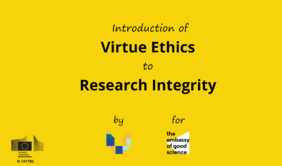Difference between revisions of "Instruction:86f47366-a189-4395-9301-36ddb6d1fc68"
From The Embassy of Good Science
| Line 26: | Line 26: | ||
{{Instruction Step Trainee | {{Instruction Step Trainee | ||
|Instruction Step Title=Take the online module | |Instruction Step Title=Take the online module | ||
| − | |Instruction Step Text=[[File:Introduction for virtue ethics.png | + | |Instruction Step Text=[[File:Introduction for virtue ethics.png|frameless|[http://courses.embassy.science/introduction_of_virtue_ethics_to_research_integrity/story.html Open the course]|left|282x282px]] |
| − | + | <br /> | |
| − | |||
| − | |||
}} | }} | ||
{{Instruction Remarks Trainee | {{Instruction Remarks Trainee | ||
Revision as of 14:11, 20 October 2020
Introduction of virtue ethics to research integrity
Instructions for:TraineeTrainer
Related Initiative
Goal
This eLearning module aims to provide an introduction to virtue ethics, and to highlight the relevance of virtue ethics for research integrity. In this course learners are invited to self-assess newly gained knowledge, relate and apply the concepts in interactive exercises, or reflect on the relevance of these concepts for their daily research practice by drawing on their prior experience.
Requirements
You need to have a background in research (i.e. be employed as researchers) or be a trainer/educator/teacher who has had experience in research in the past.
Duration (hours)
1
For whom is this important?
Method
What is this about?
By taking this interactive module you will learn about and reflect on:
- Key characteristics of virtue ethics: After watching an introductory video on virtue ethics, you will answer answer a set of questions that aim to summarize the most relevant characteristics of virtue ethics.
- Moral conflict and a moral dilemma: After an introduction to the concepts you will be asked to apply these concepts while analysis two cases from the Rotterdam Dilemma Game, one of which portrays a moral conflict, the other one a moral dilemma.
- Your own aspirations to become a more virtuous researcher: After reflecting on your overarching goals as researchers at the end of the module, you will be asked to identify the three most important virtues that describe the kind of researcher you want to be (or become).
- The influence of moral exemplar(s) on moral development and the cultivation of virtues: After reflecting on how virtues are learnt, and taught, and what a good role model/mentor entails, you will be asked to reflect on a particular situation, in which someone you looked up to inspired you to act more virtuously.
Practical Tips
Please note that no information will be saved or stored after you have closed the browser window/tab. This has two major implications: (1) Whenever you close your browser window/tab, your progress will not be saved and you will have to start the module anew. It is not necessary to complete the course in one go, but recommended to leave the browser window/tab open (and the computer/laptop running). (2) In case you aim to save your reflections, you are kindly asked to copy/paste your input in a separate document and save it on your computer, BEFORE you submit your input (A print-out solution is planned, but is not available yet).
Remarks
This training has been developed by the VIRT2UE project, which has received funding form the European Union’s H2020 research programme under grant agreement N 741782.
What is this about?
This interactive e-learning module provides an introduction to virtue ethics and its relevance for research integrity. By taking this module learners will need to:
- Demonstrate a basic understanding of key characteristics of virtue ethics. After watching an introductory video on virtue ethics, learners are required to answer a set of five multiple choice questions that aim to summarize the most relevant characteristics of virtue ethics. Learners get instant feedback on whether their responses are correct or not.
- Distinguish between a moral conflict and a moral dilemma. In an exercise that follows information about the difference between the concepts of values and norms, as well as moral conflicts and moral dilemmas, learners are required to apply these differentiations and transfer their knowledge into distinguishing two cases from the Rotterdam Dilemma Game, one of which portrays a moral conflict, the other one a moral dilemma.
- Identify with their own aspirations to become a more virtuous researcher. In a two-step exercise, learners are first invited to write their own obituary/laudatio, which requires them to adopt a perspective of temporal distance (a look into the future) and simultaneously an inter- rather than an intrapersonal perspective at themselves as researchers. This way, they may reflect on their overarching goals as researchers that may differ from their everyday aspirations. At the end of the module, learners are asked to identify the three most important virtues that the description of themselves entails.
- Reflect on the influence of moral exemplar(s) on moral development and the cultivation of virtues. In a reflection exercise following information on how virtues are learnt, and taught, and what a good role model/mentor entails, learners are invited to reflect on a particular situation, in which someone they looked up to inspired them to act more virtuously.
Practical Tips
Please note that no information will be saved or stored after users have closed the browser window/tab. This has two major implications: (1) Whenever users close their browser window/tab, their progress will not be saved and they will have to start the module anew. It is not necessary to complete the course in one go, but recommended to leave the browser window/tab open (and the computer/laptop running). (2) In case users aim to save their reflections, they are kindly asked to copy/paste their input in a separate document and save it on their computer.
1
Experience the online module
Click on the link http://courses.embassy.science/introduction_of_virtue_ethics_to_research_integrity/sto
Remarks
This training has been developed by the VIRT2UE project, which has received funding form the European Union’s H2020 research programme under grant agreement N 741782.


